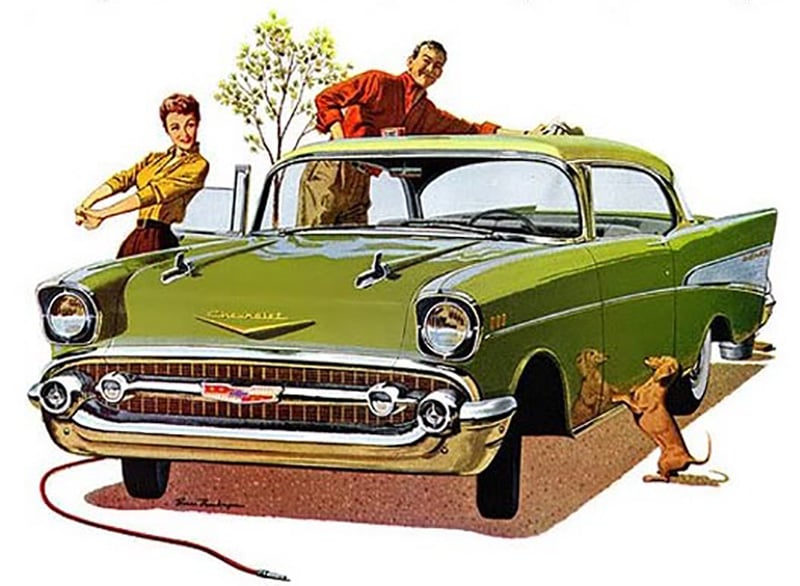When readers of the Toronto Star earlier this month found a column slamming bike lanes and accusing the city of using the pandemic crisis to install 40 kilometres of the routes “while nobody was looking,” they might have missed some facts about the writer, Norris McDonald.
His piece was labelled “special to the Star” but his bio says he’s a retired Star editor who writes for the newspaper’s automobile section "Wheels" on contract and reports on motor racing, too.
Knowing that, it’s little surprise a senior citizen who bolsters his pension writing homages to cars has nothing good to say about bicycling. And he’s clear enough about his politics. “Pay a little less attention to the bike lobby, which isn’t all that big, and a lot more to the car crowd, which is huge,” he instructs city hall. Besides, McDonald points out, car sales at dealerships were actually “way up” in May.
But the real service McDonald performed in his rant was by concisely explaining the vital role that car ads continue to play in the survival of Canada’s corporate news media, particularly during this pandemic advertising downturn.
He does that as he lets us in on some of his reporting methods: “I wanted to double-check the facts for this column so I googled ‘bike lanes Toronto’ and a local news site called Toronto.com popped up.
“The main story was about the bike-lane expansion, but that wasn’t what caught my eye. Right across the top of Toronto.com was an ad for a 2020 Kia Sorento. Even better, in the shoulder of the story, was another ad for the same car. There wasn’t an ad for a bicycle anywhere on that page. Just car ads (there was another one at the bottom). Now we know which of these two modes of transportation pays the freight around here.” He’s not wrong. The automobile industry by some estimates will spend over $1.7 billion on Canadian online advertising this year, accounting for 17 per cent of the market.
One expert on the mighty car lobby finds it refreshing that McDonald just comes clean.
“It’s sort of understood that — in the real world — in a democracy if you have more money, you have more say,” historian Peter Norton told The Tyee in an interview. “But the official fiction is that that’s not how it’s supposed to work. This guy [McDonald] seems be quite willing to say, ‘the more you pay, the more it should go your way.’
“It was striking that the author comes right out and says, ‘Look who’s paying the freight around here.’”
Norton, an associate professor of engineering and society at University of Virginia, is the author of Fighting Traffic: The Dawn of the Motor Age in the American City. Norton spent decades researching the relationship between the auto industry and the news business. After he had unearthed many interesting artifacts at the historical archives of the American Automobile Association in Florida, Norton was told they were no longer available to the public.
Over the phone, Norton noted today’s fat automobile newspaper sections run counter to the mood in the editorial pages of the early 1910s. Back then, car makers were having a difficult time convincing the public to accept their vehicles into streets where people felt safe to walk or cycle freely. The problem, as he writes in his book, is that autos kept hitting and killing pedestrians.
In fact, more Americans died from cars in the four years after the First World War than had been killed fighting in France. Most of those killed were young and on foot. The frequent response was an angry mob encircling the driver whom they automatically and fully blamed. Police arriving on the scene needed to call in reinforcements if the driver would be spared mob violence.
Newspaper letters to editors, editorials, cartoons and opinion pieces widely portrayed the car as a new deadly threat encroaching on space that by rights belonged to everyone. Norton found letters to the editor by countless angry pedestrians, some of whom issued hyperbolic threats to kill aggressive drivers.
And then came people like Roy Chapin. In 1923, he was an automotive executive and industry lobbyist, and in a letter found by Norton he explained how car makers went about solving their public relations challenges — by applying financial muscle to newspapers.
For example, the Chicago Tribune up until the 1910s “would not mention the name of any motor car in its columns” Chapin said. That changed after auto dealers simultaneously withdrew their ads in a co-ordinated manner. The paper “woke up and promised to do almost anything if they could get the advertising,” Chapin is quoted in Fighting Traffic. “Since that time they have been very decent in their attitude.”
For his own part, Chapin, the Hudson Motor Car Co. chairman, later became U.S commerce secretary.

When Norton still had access to the American Automobile Association’s historical archives in Florida, he found a book of saved clippings from newspapers dating back to the 1910s and ‘20s. They were articles wholly written by the association and then published under Washington Star reporter bylines with little or no distinguishing marks.
Today, automobile sections like the Globe and Mail’s "Drive" or the Star’s "Wheels" are common to newspapers in North America. Those who write for them include former car dealers and race drivers. A scan of members of the Automobile Journalists Association of Canada finds one after another professing their love for all things automotive.
And while newspaper content has shrunk as advertising has declined, auto sections have proven resilient. Over decades, their size “grew and grew,” bragged McDonald in 2016. His own “Wheels section, for instance, was 28 pages thick.”
But if car sales were up in May, so were bicycle purchases. In fact they were exploding.
Global News reported that stores were running out of bikes in stock. These sales were just in time for Toronto’s highly participated “ActiveTO” experiment, which has closed roads from traffic on weekends during the pandemic. It seems a lot of people might warm to the idea of a “car free road network” proposed in another Star article — a piece that McDonald admits jarred him into writing his blast at the “bicycle lobby.” (The need for such infrastructure was explained to McDonald with grace and patience by Canadian Cycling magazine.)
Canada is in the middle of adapting to many crises at once. Climate change. A pandemic. And the unravelling of journalism’s old business model.
There is irony in the fact that one gasping model for journalism remains increasingly dependent on flogging emissions-belching automobiles. The ads persist because cars are such big-ticket items, whose marketing is tied to technical details and, even more, emotional cues. This makes them a natural for the old order of mass advertising.
But Facebook’s dominance of online advertising means the ad dollars that fuelled journalism are becoming as obsolete as the internal combustion engine and ink on newsprint. Cars, and the news vehicles they’ve flooded with money, are parts of a passing paradigm. Expect, even, to see more articles like this one calling for banning car ads the way we did for cigarettes.
In the meantime, news consumers should wonder how much the car lobby skews what they read. Norton reminds us that any revolution is necessarily a war of words. The word “jaywalker,” for example, emerged from automobile industry efforts to clear the streets for their products. Jaywalker at first was the name assigned bumpkins who got in the way of other pedestrians. Unsophisticated “jays,” accustomed to wide-open farm fields, crisscrossed in front of hurried and purposeful urban pedestrians. But the auto lobby remade jaywalkers into those who deserve blame for getting in the way of cars.
A lot of the words being lobbed over the wall by the auto industry these days are aimed at preparing us for self-driving cars. There’s little discussion of how unsafe or class-widening or climate-destroying or job-killing or surveillance-enhancing such vehicles may prove to be. Instead we are made to feel their arrival is inevitable and necessary. This discussion feels a lot like how the car industry a century ago reshaped opinion, says Norton.
To be reminded that we did not always cede so much of our city space to cars, nor so much of our media space to their glorification, listen to some fulminations from the year 1921. By then “safety councils” began to form to worry about how to get cars and people to coexist in a less deadly manner, which coincided with auto industry aims. An American Automobile Association president invited a safety council guest to observe rush hour from the top of Washington’s Rigg building, quoted in Fighting Traffic.
The streets, the safety councillor said, “were absolutely black with people. They made no attempt to come anywhere near the cross-walks. An automobilist went through the crowd at his own risk. A great many of those people were not particularly careful of how they crossed the streets, they just bowled across.”
It’s the sort of nightmare scene that could keep a Wheels writer up at night. ![]()
Read more: Media
















Tyee Commenting Guidelines
Comments that violate guidelines risk being deleted, and violations may result in a temporary or permanent user ban. Maintain the spirit of good conversation to stay in the discussion.
*Please note The Tyee is not a forum for spreading misinformation about COVID-19, denying its existence or minimizing its risk to public health.
Do:
Do not: